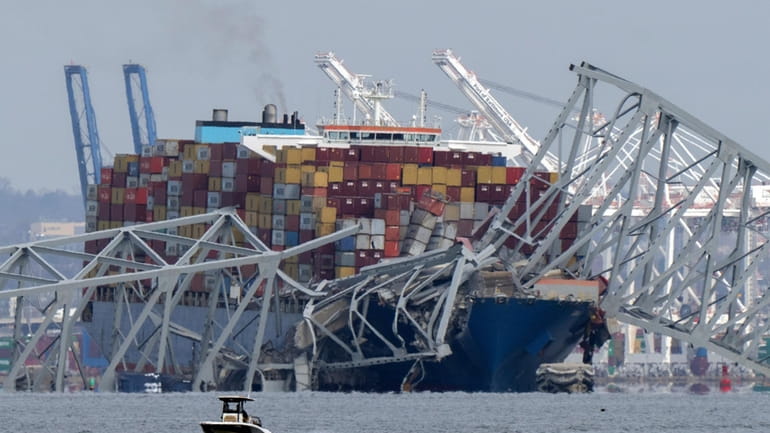Bridging fears in Baltimore ship strike

A container ship rests against the wreckage of the Francis Scott Key Bridge in Baltimore Tuesday. Credit: AP/Mark Schiefelbein
If you have ever felt apprehensive driving over a long bridge span, you might have become even queasier watching the video of Tuesday’s tragic collapse of Baltimore’s Francis Scott Key Bridge after it was hit by a heavy cargo ship. The awful images reinforce our fears by reminding us that such events can occur. And they underscore the importance of maintaining our infrastructure to ensure our bridges, tunnels, rails, and roads are safe, reliable, and well-inspected.
The bridge disaster also raises questions about the increasingly larger ships on our waterways, the ability of older structures to withstand such shocks, the quality and frequency of safety inspections of international freight vessels entering U.S. ports, and the possible need to reevaluate navigation in critical facilities such as the Port of New York and New Jersey to minimize the chances of such collisions.
This disaster will be a dislocating roadblock for travel around the Washington, D.C. area as the failed bridge is cleared away and replaced. Commerce dependent on the flow of ships in and out of Baltimore’s busy harbor will be slowed as well. The disaster will affect the regional and national economy for months in ways that have yet to play out. More foreign cars enter the Port of Baltimore than any other U.S. port; such overseas shipments might have to be redirected. Clearly, federal funding will be needed to restore this vital link.
In assessing the damage, federal authorities must determine what lessons can be applied to improving other critical bridges, especially in highly populated places like the New York metro area and Long Island, which is so dependent on bridges for its economic vitality. Authorities should look at the design of existing bridges, especially older ones that can barely accommodate the mammoth modern ships that pass underneath. If a column holding up a bridge is hit by one of these behemoths, can we avoid a major catastrophe? Are protective devices called “dolphins” surrounding these bridges, including the Key Bridge, sufficient enough to withstand strikes by errant vessels?
The speed of the ship in Baltimore also seems a factor in the Key Bridge's demise. Did local authorities miss some basic warning signals that a collision was imminent? How much independent safety review exists of international ships entering our waterways — the Dali, sailing under the flag of Singapore, has had problems before — and does that need improvement, especially if the ship’s internal systems prove faulty? Could more humans on tugboats, or additional electronic monitors and wider video capabilities around the Baltimore bridge, have changed the outcome? Are monitors for New York’s bridges adequately prepared to ensure safety here?
It is sobering to note that from 1960 to 2015, ship or barge collisions caused 35 major bridge collapses, 18 in the U.S.
Disasters like these open our eyes and demand improvements. After yesterday’s tragedy, we are just beginning to cross the bridge toward recovery and better safety.
MEMBERS OF THE EDITORIAL BOARD are experienced journalists who offer reasoned opinions, based on facts, to encourage informed debate about the issues facing our community.
